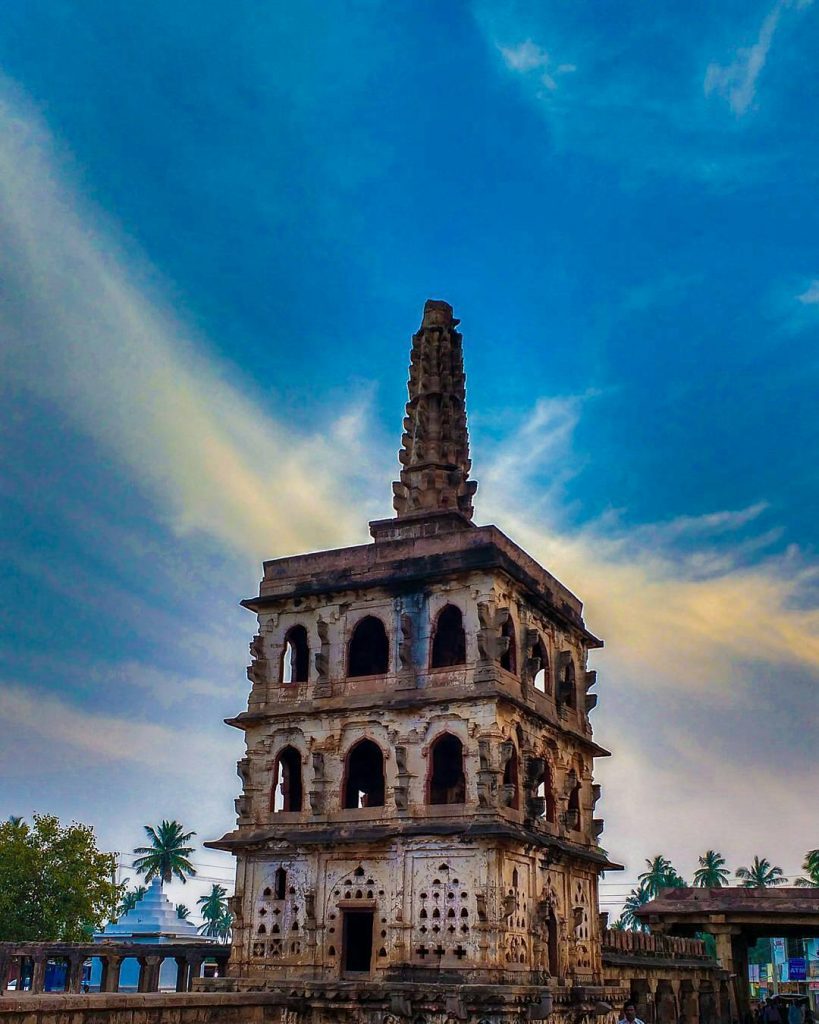Explore the forgotten heritage of ancient times at The Temple of Banashankari Amma, Badami, Karnataka

In Cholachagudd, a village close to Badami in Karnataka, there is a temple called Banashankari, also referred to as Banashankari Amma is a great tourist attractions. It ranks among the most well-known Hindu shrines in the region. Among various tourist places the monastery is the subject of numerous myths and legends that relate to its building, past, and present. But the most intriguing thing about this monastery is that people revere ‘Rahukala,’ which is unlucky in Hindu culture. The followers of Rahukala implore him to free them from all suffering, adversity, and bad fortune. Thus making it one of the best tourist spots.
The Nagara and Dravidian architectural styles were used in the construction and renovation of the Banashankari monastery, giving it a harmonious history. Every January, during the cultural and religious festival of Banashankari Jatre, it has continued its heritage of unification as devotees from Karnataka but also neighboring states flock there to express their dedication and take part in the cultural and fare activities. The Haridra Tirtha is a lake in the temple premises with a towering light fixture over a 3 story building.
The Banashankari Temple’s history
This monastery doesn’t have a clearly defined beginning date, comparable to numerous other ancient Hindu shrines. The initial monastery, however, is thought to have been erected in the seventh century AD by Kalyani Chalukya kings. Through the writings, Jagadekamalla I managed to install the Goddess Banashankari deity in the black stone statue in 603 AD. Even though the monastery may have been built earlier, his improvements went above and beyond the original design. The Deity Banashankari served as the tutelary divinity for the Chalukya ruling family and was idolized as “Shakti,” a most powerful celestial being. Writings from 1019 AD that praise the valor of the Rashtrakuta king Bhimadeva were additionally discovered in the monastery. The historical truth of this monastery is thus still a mystery.
The design and construction of the Banashankari Temple
Dravidian architecture was used to build the monastery initially, and Islamic and Vijayanagara architectural influences also crept in during renovations. The primary building is made up of an exterior portico named Mukha Mandapa, an entry platform known as Ardha Mandapa, as well as the sanctum sanctorum termed Garbha Griha, in which the deity is housed and whose roof is crowned by a tower termed Vimana and is a great sightseeing places. The deity is trying to kill the devil that is lying at her legs while perched atop her signature lioness. She carries the spear, she preferred consensus weapon, in addition to the battle bell, blade, safeguard, Vedic manuscripts and religious texts which shows the skull warship, and damaru or hand drum.
The square water storage tank renamed Haridra Tirtha from Harishchandra Tirtha, is located directly in front of the entry to the Banashankari monastery. For worshippers to stroll around there for Pradakshina, a route has been labeled around the entire water feature.
Visitor Advice for the Banashankari Temple
- It is purely forbidden to take pictures within the monastery, particularly of the divinity. Respect the laws and remember to do so.
- Don’t neglect to try the dry Jawar roti, curd, and chutney that are offered nearby the monastery campus at an incredibly affordable price.
Facts about Banashankari Amma Temple
- The Banashankari Rath Yatra is an annual celebration that begins on a full moon day in January. The monastery chariot pulls the Deity in a cavalcade thru the village roads. Both residents of Karnataka and visitors from the surrounding states attend this carnival.
- In addition to the Rath Yatra, there is a local culture and religious festival called the Banashankari Jatre. It’s a hybrid fair that combines amusement and business.
- All around the monastery, numerous local stores are selling a wide range of goods.
- It’s fascinating to observe that Muslims run several shops offering distinctively Hindu goods such as holy threads and vermilion among many others.
- During Jatre, there is a renowned livestock fair.
Looking to explore more and experience the true local vibes, check out our exclusive local trip packages. The customised trip itineraries are made just for you based on your preferences.
Click Here to Explore Our Exclusive Local Itineraries
Disclaimer: Localhey claims no credit for images featured on our blog site unless otherwise noted. All visual content is copyrighted to its respectful owners. We try to link back to original sources whenever possible. If you own the rights to any of the images, and do not wish them to appear on Localhey, please contact us and they will be promptly removed.
0 Comments